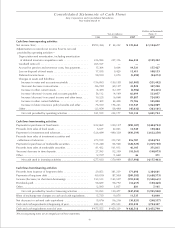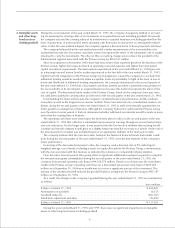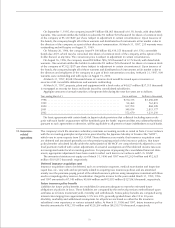Sony 1997 Annual Report Download - page 48
Download and view the complete annual report
Please find page 48 of the 1997 Sony annual report below. You can navigate through the pages in the report by either clicking on the pages listed below, or by using the keyword search tool below to find specific information within the annual report.
46
Derivative financial instruments
Derivative financial instruments are used in the company’s risk management of foreign currency and interest
rate risk exposures of its financial assets and liabilities. Gains and losses on derivative financial instruments
qualified as hedges to manage existing financial assets and liabilities are deferred and effectively offset gains
and losses arising from the related assets and liabilities. Others used for hedging purposes but not qualifying
for hedge accounting under U.S. GAAP are marked to market.
In July 1995, the Emerging Issues Task Force (EITF) of the Financial Accounting Standards Board (FASB)
reached a consensus with regard to EITF No. 95-2, Determination of What Constitutes a Firm Commitment
for Foreign Currency Transactions Not Involving a Third Party. EITF No. 95-2 requires companies to mark to
market forward exchange contracts to hedge intercompany foreign currency commitments which do not
qualify as firm commitments as defined by such consensus. Accordingly, the company has applied the provi-
sions of EITF No. 95-2 effective as of the second quarter of the year ended March 31, 1996. Previously, gains
or losses on those forward exchange contracts to hedge intercompany foreign currency commitments have
been deferred in accordance with FAS 52 and EITF No. 91-1. The application of the provisions of EITF No.
95-2 did not have a material impact on the results of operations for the years ended March 31, 1996 and 1997.
Net income (loss) per common share
Net income (loss) per common share is computed based on the average number of shares of common stock
outstanding during each period after consideration of the dilutive effect of common stock equivalents which
include warrants and certain convertible bonds. Net income (loss) per common share is appropriately
adjusted for any free distributions of common stock.
In February 1997, the FASB issued FAS 128, Earnings per Share, which replaces the presentation of primary
Earnings per Share (EPS) with a presentation of basic EPS and also requires dual presentation of basic and
diluted EPS with an appropriate reconciliation of both computations. Basic EPS is computed based on the
average number of shares of common stock outstanding during each period. Diluted EPS assumes the dilution
that could occur if securities or other contracts to issue common stock were exercised or converted into com-
mon stock or resulted in the issuance of common stock. This Statement is effective for the both interim and
annual periods ending after December 15, 1997. Earlier application is not permitted. After the effective date,
all prior-period EPS data presented shall be restated to conform with this Statement. Under the provisions
of this Statement, the company’s basic EPS for the years ended March 31, 1995, 1996 and 1997 would be
¥(784.7), ¥145.1 and ¥367.7 ($2.97), respectively, and also its diluted EPS for the years ended March 31,
1995, 1996 and 1997 would be ¥(784.7), ¥134.0 and ¥309.2 ($2.49), respectively (yen amounts in parentheses
represent loss per share).
Distribution of common stock
On occasion, the company may make a free distribution of common stock which is accounted for either by a
transfer of the applicable par value from the additional paid-in capital to the common stock account or with
no entry if free shares are distributed from the portion of previously issued shares accounted for as excess of
par value in the common stock account. Under the Japanese Commercial Code, a stock dividend can be
effected by an appropriation of retained earnings to the common stock account by resolution of the general
stockholders’ meeting and the free share distribution with respect to the amount as appropriated by resolution
of the Board of Directors’ Meeting.
Common stock issue costs
Common stock issue costs are directly charged to retained earnings, net of tax, in the accompanying con-
solidated financial statements as the Japanese Commercial Code prohibits charging such stock issue costs to
capital accounts which is the prevailing practice in the United States of America.
Reclassifications
Certain reclassifications of the statements of income and retained earnings in the years ended March 31, 1995
and 1996 have been made to conform with the presentation in the year ended March 31, 1997.
U.S. dollar amounts presented in the financial statements are included solely for the convenience of the
reader. These translations should not be construed as representations that the yen amounts actually represent,
or have been or could be converted into U.S. dollars. As the amounts shown in U.S. dollars are for conve-
nience only, the rate of ¥124=U.S. $1, the approximate current rate at March 31, 1997, has been used for the
purpose of presentation of the U.S. dollar amounts in the accompanying consolidated financial statements.
3. U.S. dollar
amounts
























